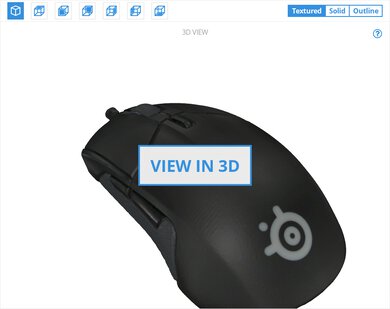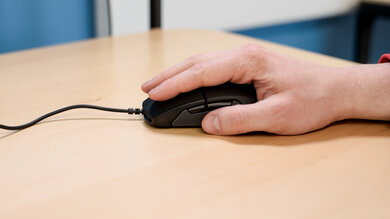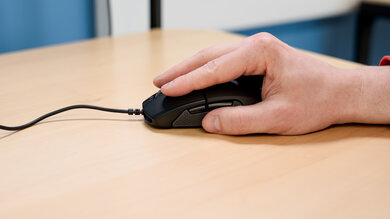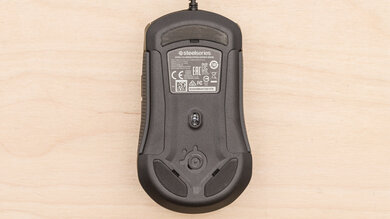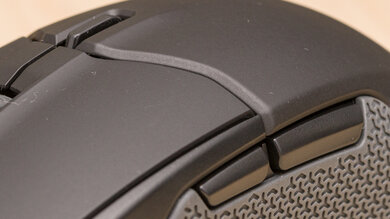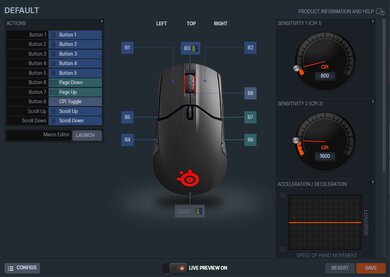The SteelSeries Sensei 310 is a great wired gaming mouse. It feels sturdy, has two side buttons on each side, and has a comfortable ambidextrous shape that's ideal for claw grip regardless of hand size, though it's also suitable for a fingertip grip for larger hands or a palm grip for smaller hands. It has good click latency, a good lift-off distance, a wide CPI range, and a set CPI that you can adjust by increments of 100. Unfortunately, it has a fairly stiff rubber cable, and our unit's sensor is somewhat inconsistent, as it undershoots the set CPI more for faster mouse movements than slower ones.
Our Verdict
The SteelSeries Sensei 310 is decent for office use. It feels well-built and has an impressive number of programmable buttons. It's best suited for a claw grip, but it's also suitable for smaller hands using a palm grip or larger hands using a fingertip grip. Unfortunately, it's a wired-only mouse, and the scroll wheel lacks L/R tilt buttons and doesn't unlock for free scrolling.
- Feels well-built.
- All buttons are programmable.
- Wired-only.
- Mouse wheel lacks L/R tilt buttons and doesn't unlock for free scrolling.
The SteelSeries Sensei 310 is very good for FPS gaming. It feels sturdy, has good click latency, good mouse feet that glide smoothly on mousepads, and it's ideal for a claw grip for all hand sizes. Unfortunately, the cable is fairly stiff, the lift-off distance isn't as low as on some gaming mice, and the sensor is somewhat inconsistent, undershooting the set CPI more for faster mouse movements than slow ones.
- Good click latency.
- Feels well-built.
- All buttons are programmable.
- Fairly stiff rubber cable.
- Borderline heavy.
The SteelSeries Sensei 310 is very good for gaming, but it doesn't have as many side buttons as dedicated MMO mice. That said, it does have a pair of buttons on either side, and all the buttons are programmable. It feels well-built and has software compatible with Windows and macOS. It also has a good click latency and lift-off distance. It's ideal for a claw grip for all hand sizes, but it's also suitable for larger hands using a fingertip grip or smaller hands using a palm grip.
- Good click latency.
- Feels well-built.
- All buttons are programmable.
- Not as many side buttons as dedicated MMO mice.
The SteelSeries Sensei 310 is good for ultra-light gaming, but it's on the edge of being considered heavy and has a stiff rubber cable. That said, it feels well-built, its feet glide smoothly on mousepads, and it has a comfortable ambidextrous shape that's well-suited for claw grip regardless of hand size. Unfortunately, the unit we tested has a somewhat inconsistent sensor and undershoots the set CPI.
- Good click latency.
- Feels well-built.
- All buttons are programmable.
- Fairly stiff rubber cable.
- Borderline heavy.
The SteelSeries Sensei 310 is inadequate for travel. It's bulky, so it may not fit in most laptop cases, and it's a wired mouse, which can make it cumbersome in tight spaces like trains, buses, or planes. On the other hand, it feels well-built, has companion software compatible with Windows and macOS, and has onboard memory for settings.
- Feels well-built.
- Wired-only.
- Fairly bulky; may not fit in most laptop cases.
Check Price
Differences Between Sizes And Variants
The SteelSeries Sensei 310 gaming mouse has no variants. The SteelSeries Rival 310 is a nearly identical mouse internally, but it has a right-handed ergonomic shape and two side buttons only on the left. You can see the label for our unit here.
Popular Mouse Comparisons
The SteelSeries Sensei 310 gaming mouse is marketed towards esports and competitive FPS players. While it offers solid performance, there are many gaming mice within the same price bracket point that are lighter, have more flexible cables, better mouse feet, more consistent sensors, and lower click latency. That said, shape is one of the most important elements when choosing the right gaming mouse, and the Sensei 310's ambidextrous shape is popular among some claw and fingertip grip fans.
For more options, check out our recommendations for the best mouse, the best wired mouse, and the best gaming mouse.
The SteelSeries Sensei 310 is an updated version of the SteelSeries Sensei RAW. It has a slightly different shape, feels more sturdy, and has a wider CPI range. On the other hand, the Sensei RAW is lighter, has a lower lift-off distance, and a more consistent sensor. Both mice are ideal for claw grip with any hand size and suitable for larger hands using a fingertip grip, though the Sensei 310 is more suitable for smaller hands using a palm grip.
The Razer DeathAdder V2 is a better wired gaming mouse than the SteelSeries Sensei 310. It's significantly lighter, has a more flexible cable, and much better mouse feet. It also has a wider CPI range, a more adjustable CPI, a lower lift-off distance, a more consistent sensor, and a lower click latency. On the other hand, the SteelSeries feels sturdier, has two more side buttons, and its companion software is compatible with Windows and macOS. Both mice are well-suited for all grip types and most hand sizes, but the SteelSeries is more accomodating for smaller hands.
The SteelSeries Sensei Ten and the SteelSeries Sensei 310 are great ambidextrous gaming mice with two side buttons on either side. The Sensei Ten is lighter and has better mouse feet, a wider CPI range, a set CPI that's more precisely adjustable, a more consistent sensor, and newer software. It's best suited for a claw or palm grip for nearly all hand sizes. Comparatively, the Sensei 310 has rubberized sides and feels much more comfortable. It's ideal for a claw grip for all hand sizes.
The Razer Viper Mini is a comparable gaming mouse to the SteelSeries Sensei 310. It's much lighter, has a more flexible cable, much lower click latency, and mouse feet that glide more smoothly. Unfortunately, its software is only compatible with Windows. Comparatively, the SteelSeries has two additional side buttons, a wider CPI range, and software compatible with Windows and macOS. The Razer is best-suited for a fingertip grip, while the SteelSeries is best-suited for a claw grip, though both are suitable for other grip types depending on hand size.
Test Results

If you're interested in a gaming mouse with similar performance but a right-handed shape, check out the Corsair HARPOON RGB PRO.
The unit we tested has a somewhat inconsistent sensor that undershoots the set CPI more during quicker cursor movements. The polling rate settings are 125Hz, 250Hz, 500Hz, and 1000Hz.
If you'd prefer a similarly performing mouse that allows you to make basic RGB lighting and CPI adjustments without companion software, check out the Cooler Master CM110.


